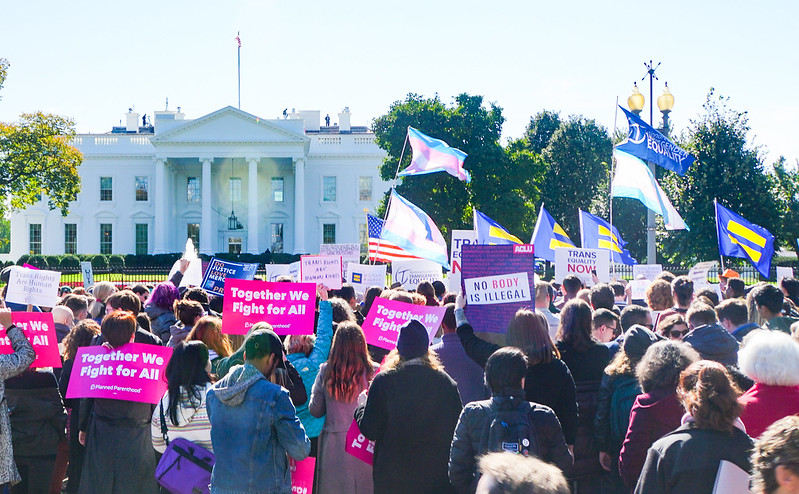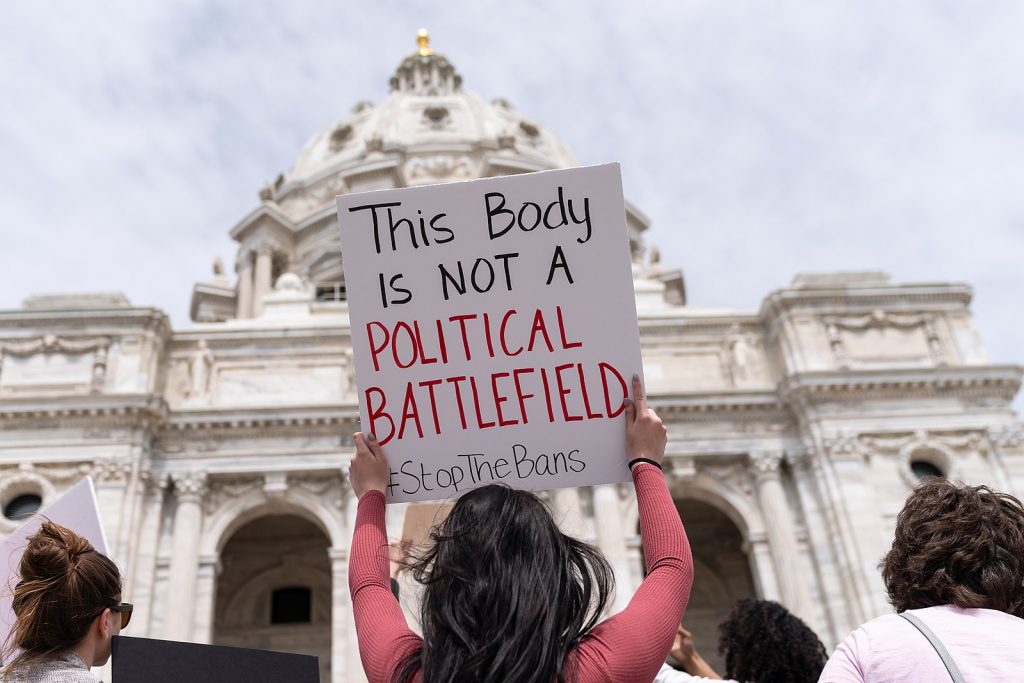For The Weekly Pulse (a revisit of an old Ms. column!), we’ve scoured the most trusted journalistic sources—and, of course, our Twitter feeds—to bring you this week’s most important news stories related to health and wellness.
In this edition, we highlight some examples of lawmakers attacking trans rights and health care; track the growing number of anti-abortion legislation; provide updates on the potential for a fourth wave of COVID-19; and take a look at health care affordability, new research on using CRISPR technology for chronic pain and a new study on adolescents and drug use.
Lawmakers Attack Trans Health and Rights

+ Though we are only a third of the way through the year, conservative legislators have introduced more than 80 bills that impact and harm trans health and rights. Many seek to block gender-affirming care for transgender children and ban their participation in sports.
This past week alone, Arkansas lawmakers passed:
- SB 354, banning transgender women and girls from participating in sports at the elementary, middle, high school and collegiate levels.
- HB 1570, the first legislation of its kind, banning doctors from providing gender-affirming health care to transgender minors.
- SB 289, allowing health care professionals to deny nonemergency care based on religious, moral or ethical obligations.
Repro Rundown: “One of the Most Hostile [Legislative Seasons] in History for Reproductive Health”

+ Over 500 abortion restrictions have been introduced in 44 states this year—an increase from 300 restrictions this time in 2019, says a report from Planned Parenthood and the Guttmacher Institute.
“This legislative season is shaping up to be one of the most hostile in recent history for reproductive health and rights,” said Alexis McGill Johnson, president and CEO of Planned Parenthood. “These abortion restrictions are about power and control over our bodies.”
+ Legislation requiring patients undergoing a medication abortion must be informed of the potential to stop the effects of the procedure just passed in the West Virginia House of Delegates. HB 2982 is designed to compel physicians to provide information that is not scientifically-supported and “goes against the standard of care.”
+ South Dakota Gov. Kristi Noen just signed four anti-abortion bills into law.
- HB 1110 bans abortion based on a diagnosis of Down Syndrome.
- SB 183 declares that certain contract provisions regarding abortion are unenforceable.
- HB 1114 provides harmful definitions regarding abortion.
- HB 1130 establishes requirements for the presentation of a written statement with medically-unsupported information about the discontinuance of medication abortion.
+ A “heartbeat ban” passed by the Texas Senate is now on its way to the state House. SB 8 aims to ban abortion after a heartbeat is detected. The legislation does provide exceptions to save the life of the pregnant person, but not for rape or incest. However—as we’ve said before—these exceptions do not make anti-abortion legislation in any way “better” because any legislation that limits a person’s right to have an abortion is bad legislation.
“[This] extreme political agenda is not what Texans need or want right now. In fact, the majority of Texans support access to safe, legal abortion,” said Planned Parenthood Texas Votes executive director Dyana Limon-Ricardo. “Texans believe that abortion should be accessible. Nobody should face fear, stigma or unnecessary barriers when seeking out reproductive health care, including abortion care and deciding on how to plan their families.”
+ In Ohio, Planned Parenthood announced it has filed a lawsuit over the state’s ban on telemedicine abortion care. This comes after Gov. Mike DeWine signed SB 260, requiring a doctor be present when patients take the initial dose of mifepristone, with violation resulting in a fourth degree felony.
+ Two anti-abortion bills have passed in the Wyoming House and are on their way to the state Senate. HB 161 outlaws abortions performed for “discriminatory” reasons, like disability. HB 253 would not allow any state or federal funds to go towards student insurance plans at public Wyoming universities or community colleges whose plans cover abortion care. State funds would also not be given to public colleges or universities for elective abortion procedures.
+ The Arizona House approved legislation making it a felony for physicians to perform an abortion due to the fetus having a “survivable genetic abnormality.”
+ Florida lawmakers are considering a bill that would ban abortion care after 20 weeks of pregnancy—“vilifying abortion later in pregnancy, regardless of the real-world harms to pregnant people.”
+ Access to contraceptives and reproductive care is a global human right that the United States will be monitoring, said Secretary of State Antony J. Blinken on Tuesday. This comes as the State Department reverses Trump administration policies on reproductive and religious freedoms.
Blinken also announced that he had dismantled an advisory committee, created by Mike Pompeo, that placed religious liberties and property under the umbrella of universal freedoms. Some accused Pompeo of using the committee to promote his own personal evangelical Christian, conservative beliefs.
Can the U.S. Avoid a Fourth Wave of Coronavirus Deaths?
+ As businesses reopen and Americans resume their normal activities, public health experts are warily watching for a potential fourth wave of COVID-19 infections. Although deaths and hospitalizations have been trending downward overall (thanks in part to the success of vaccinations), there’s been a small uptick in both of these categories over the past week. The daily number of new cases is hovering at around 70,000 per day—11 percent higher than two weeks ago.
At a White House briefing on March 29, CDC Director Dr. Rochelle Walensky described feeling a sense of “impending doom” about the rising number of cases. The more-contagious and potentially more-lethal B.1.1.7 variant is accounting for an estimated 26 percent of the new cases, although the number is likely even higher, due to a lack of widespread genomic sequencing on COVID-19 tests. States including Michigan, Florida and New Jersey are seeing rising case numbers due to the variant. The B.1.1.7 variant is also fueling a troubling rise in hospitalizations among young people.
“Just please hold on a little while longer,” Dr. Walensky said. “I so badly want to be done. I know you all so badly want to be done. We are just almost there, but not quite yet. And so I’m asking you to just hold on a little longer to get vaccinated when you can—so that all of those people that we all love will still be here when this pandemic ends.”
+ The U.S. is currently administering an average of 2.5 million doses per day, and at least 34 states are aiming to expand eligibility to all adults by mid-April. Public health experts are reminding the public to wait until they are fully vaccinated to resume certain activities, which can take a few weeks after receiving your final dose of vaccine.
+ The CDC updated its guidelines for fully vaccinated people, who can now “resume domestic travel and do not need to get tested before or after travel or self-quarantine after travel.” Vaccinated travelers should still continue to practice social distancing, hand washing and mask wearing in order to be “mindful of the potential risk of transmitting the virus to others.”
+ The Biden administration officially introduced its pro-vaccine messaging campaign this week, which aims “to encourage vaccinations and increase vaccine confidence.” The campaign will mobilize local leaders—dubbed as the COVID-19 Community Corps—to provide the public with “consistent and accurate information about COVID-19” in order to “empower as many Americans as possible to become messengers to share the importance of vaccination in their community.”
The messaging campaign is directly trying to stem the spread of misinformation and disinformation, which have flourished on social media platforms like Facebook. Anyone can sign up to become part of the community corps and receive shareable fact sheets, social media content to share and regular email updates.
+ We’ve talked a lot about the effect of the pandemic on mental health, but what about its effects on our physical health? As Amanda Mull details in The Atlantic, the stress of the year has led to increased reports of back, leg and foot pain as people spend more time sitting and less time moving. Additionally, prolonged stress has led to increased hair loss, skin picking and nail biting. Loneliness and isolation also contribute to an increased risk of myocardial infarction and stroke.
Those who menstruate are also reporting painful periods and more intense symptoms of PMS during the pandemic. All this is to say that the pandemic has been hard on both our mental and physical well-being, so engaging in self care practices such as light exercise, stretching and meditation, as well as seeking medical attention when needed, will continue to be especially important until the pandemic is over.
In Other News…
+ A new West Health-Gallup survey concluded “Americans are borrowing tens of billions of dollars, skipping treatments and significantly cutting back on household spending to pay for basic health care, yet a wide partisan divide exists over their satisfaction with the current U.S. healthcare system and the quality of care it provides.” Among Republicans, 67 percent say the quality of health care in the U.S. is “the best” or “among the best” in the world, while that number is just 38 percent among Democrats.
While none of the findings should be surprising to anyone who’s paid attention to the health care debate, the survey results are still upsetting. Over the past year, one in four Americans skipped medical treatment because of the cost. Twelve percent of Americans were forced to reduce food spending in order to pay for healthcare; the same number was nearly 25 percent among those earning less than $24,000 per year. Twenty-one percent of low-income households reduced spending on utilities in order to pay for health care.
+ The survey also found racial disparities in health care accessibility between Black and white Americans. Twenty-nine percent of Black Americans said they wouldn’t be able to pay for health care, in contrast to 16 percent of white Americans. Last year, Americans borrowed $88 billion to pay for health care expenses.
Despite the U.S. having the highest costing health care in the world, we consistently rank near the bottom in terms of quality of care when compared to our peer nations. On April 1, the Biden administration announced it has lowered marketplace health care costs by making new tax credits available to consumers as part of the American Rescue Plan.
+ New research shows that CRISPR gene editing technology could help create treatments that deliver long-lasting chronic pain relief. Researchers found that CRISPR can be used to “‘turn off’ a gene in critical neurons to block the transmission of pain signals” in mice. In the experiment, mice suffering due to inflammatory and chemotherapy-induced pain were injected with a version of CRISPR known as “dead” Cas9. Rather than cutting DNA like other versions of CRISPR, CRISPR-dead Cas9 only “sticks to its gene target and blocks its expression.”
Incredibly, the treatment provided pain relief to mice for at least three months, and did not produce any side effects. Importantly, the technology could become an alternative to opioids, which carry a high risk of addiction when used for chronic pain and can lead to a fatal overdose.
+ A new study found that those who use cannabis or misuse prescription drugs for the first time during adolescence (ages 12-17) have a higher likelihood of developing substance use disorder in comparison to those who first use drugs as young adults (ages 18-25). According to Emily B. Einstein, Ph.D., chief of NIDA’s Science Policy Branch and a co-author of the study:
“Research has shown that brain development continues into a person’s 20s, and that age of drug initiation is a very important risk factor for developing addiction. This underscores the importance of drug use prevention and screening for substance use or misuse among adolescents and young adults. Offering timely treatment and support to young people who need it must be a public health priority.”
Up next:





